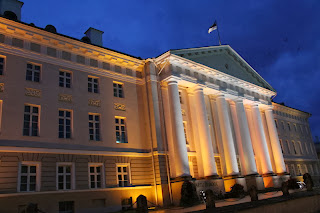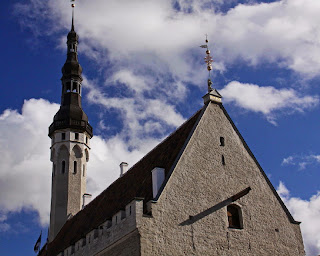Clambering over the bow of the Zodiac, we
were immediately amongst hundreds of sea lions lounging and socializing along
the sandy beach. Some were dozing in the sun. Little pups suckled their
mothers. Others waddled into and out of the sea. The sea lions were indifferent
to us humans, so we wandered, barefoot, among them, staring wide-eyed and
photographing to our hearts’ content. Pelicans and blue-footed boobies patrolled
in the sky and every few moments one would transform into a svelte dagger and
plunge into the water. A hawk watched from the cliff top.
I was on a tour in the Galapagos Islands,
those isolated, arid volcanic islands that sit astride the equator about 1,000
kilometres west of Ecuador. As I was learning, these islands are home to the
most remarkable displays of nature on this planet.
At one end of the beach, we saw what
appeared to be a confrontation. A pelican stood atop a great rock, like the
king of the castle. Its long beak pointed diagonally downward at a black marine
iguana only two feet away that appeared to be climbing to conquer the top.
Dozens of bright red and black Sally Lightfoot crabs were scattered on the rock
like spectators, a few small ones even riding on the iguana, which was about
3-feet long and looked like it had come directly from the Paleozoic era. It was
an unusual and beautiful tableau. I was
excited!
We proceeded to walk around the island,
barren, dusty and dotted with large cacti. But where the land met the water,
life thrived. The most bizarre were large groups of the prehistoric-looking
marine iguanas. They lounged lazily together, often flopped right on top of
each other. The guide explained that they swim and seek food in the sea and
then later, back on land, blow saltwater out their nostrils.
Too soon the tour ended, and we motored
back to the Galapagos Legend, a 100-passenger cruise ship, where we
lived in comfort. Over four wonderful days, we did three tours daily.
Each tour was fabulous, with one incredible
surprise following another. We saw 150-year-old, lumbering tortoises, one with
a black cowbird sitting placidly aboard its shell. We strolled amongst a colony
of blue-foot boobies and watched intricate courtship dances. In the
frigate-bird nesting area, males puffed out large bright-red balloons under
their chins, striving to impress females. At a lake, elegant flamingos walked,
seeking food under the shallow water. We saw yellow warblers and, of course,
the ordinary-looking finches, whose beaks helped Charles Darwin decipher the
processes of evolution.
When snorkeling, I marveled at schools of
colourful fish and at large turtles, who swam underwater like ballet dancers. A
young sea lion swam just below and turned upside down to get a better view of
me. Occasionally a shark would glide past like a stealth bomber, causing my
heart to momentarily stop beating.
 Every night we would recount the
astonishing sights we had seen — as Darwin and his companions must have — while
watching the blazing sun drop into the sea.
Every night we would recount the
astonishing sights we had seen — as Darwin and his companions must have — while
watching the blazing sun drop into the sea.
If You Go, You Gotta Know
Galapagos Info: www.galapagosislands.com/
Galapagos Legend: www.discovergalapagos.com/GalapagosLegend/






















































